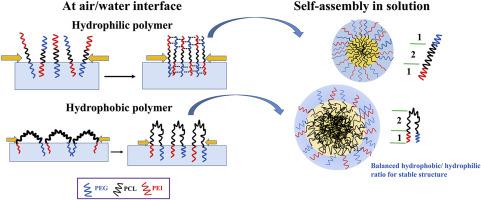Acta Pharmaceutica Sinica B ( IF 14.7 ) Pub Date : 2020-01-20 , DOI: 10.1016/j.apsb.2020.01.006 Ji Li 1 , Yitian Du 1 , Haitao Su 1 , Shixuan Cheng 1 , Yanxia Zhou 1 , Yiguang Jin 2 , Xian-Rong Qi 1

|
This study aimed to explore the link between block copolymers’ interfacial properties and nanoscale carrier formation and found out the influence of length ratio on these characters to optimize drug delivery system. A library of diblock copolymers of PEG-PCL and triblock copolymers with additional PEI (PEG-PCL-PEI) were synthesized. Subsequently, a systematic isothermal investigation was performed to explore molecular arrangements of copolymers at air/water interface. Then, structural properties and drug encapsulation in self-assembly were investigated with DLS, SLS and TEM. We found the additional hydrogen bond in the PEG-PCL-PEI contributes to film stability upon the hydrophobic interaction compared with PEG-PCL. PEG-PCL-PEI assemble into smaller micelle-like (such as PEG-PCL4006-PEI) or particle-like structure (such as PEG-PCL8636-PEI) determined by their hydrophilic and hydrophobic block ratio. The distinct structural architectures of copolymer are consistent between interface and self-assembly. Despite the disparity of constituent ratio, we discovered the arrangement of both chains guarantees balanced hydrophilic–hydrophobic ratio in self-assembly to form stable construction. Meanwhile, the structural differences were found to have significant influence on model drugs incorporation including docetaxel and siRNA. Taken together, these findings indicate the correlation between molecular arrangement and self-assembly and inspire us to tune block compositions to achieve desired nanostructure and drug loading.
中文翻译:

三嵌段聚乙二醇-聚己内酯-聚乙烯亚胺共聚物的界面性质和胶束化。
本研究旨在探讨嵌段共聚物的界面性质与纳米级载体形成之间的联系,并找出长度比对这些特性的影响,以优化药物递送系统。合成了 PEG-PCL 的二嵌段共聚物和带有额外 PEI 的三嵌段共聚物 (PEG-PCL-PEI) 库。随后,进行了系统的等温研究,以探索空气/水界面处共聚物的分子排列。然后,利用 DLS、SLS 和 TEM 研究了自组装过程中的结构特性和药物封装。我们发现,与 PEG-PCL 相比,PEG-PCL-PEI 中额外的氢键有助于疏水相互作用下的薄膜稳定性。 PEG-PCL-PEI 组装成较小的胶束状(例如 PEG-PCL4006-PEI)或颗粒状结构(例如 PEG-PCL8636-PEI),具体取决于其亲水性和疏水性嵌段比率。共聚物独特的结构体系在界面和自组装之间是一致的。尽管组成比例存在差异,但我们发现两条链的排列保证了自组装过程中亲水-疏水比例的平衡,从而形成稳定的结构。同时,发现结构差异对包括多西紫杉醇和siRNA在内的模型药物掺入有显着影响。总而言之,这些发现表明了分子排列和自组装之间的相关性,并启发我们调整嵌段组成以实现所需的纳米结构和药物负载。










































 京公网安备 11010802027423号
京公网安备 11010802027423号